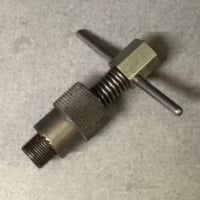Welcome! Here are the website rules, as well as some tips for using this forum.
Need to contact us? Visit https://heatinghelp.com/contact-us/.
Click here to Find a Contractor in your area.
If our community has helped you, please consider making a contribution to support this website. Thanks!
Flexible Gas Piping do's and dont's
Options
jmholt
Member Posts: 2
in Gas Heating
Had a question about when it is acceptable to use flexible gas piping and when it is not. One of my co-workers came across a commercial rooftop unit approximately 150,000 btuh on a job that was hard piped in 3/4 up to the gas-cock and then run in flex 3/4 to the gas valve (approximately 3 ft) and he wanted to know if it was up to code. Any suggestions or versions of the codes books to refer to?
0
Comments
-
That would be legal as far as I know. Did they use a flexible appliance connector or CCST?
I would rater have it hard piped if it was mine0 -
Here is a picture he sent me. When I looked closer I could see his model- looks like a Lennox KGA240 which would almost double the btuh I thought he was working with. Pipe size may be 1” looks to be CCST0
-
Not in NYC0
-
-
-
That is NOT an approved flexible connector. Also if you are in an area that has frost, drip pockets are prohibited because they can crack.0
-
CSST can't be used as a connector which is why I asked about that in my first post.
He should have hard piped it. It's close enough to do it with nipples wouldn't have needed a threader.
Not sure if I have seen appliance connectors rated for outdoor use but they must be available0 -
-
I thought that was a power steering hose for a second until I realized it was a short piece of the type of csst that has a metal braid and rubber on the outside to try to keep it from getting perforated in a lighting strike.0
-
@GroundUp
It's probably low pressure gas you can see the pipe coming up through the roof the main must be run indoors. Very common around here. A lot of cities and town don't have high pressure gas2 -
Unless I remember wrong, you can run csst directly to an appliance if it not a portable unit. At least I have seen a few done this way, and the gas company allows it. The line also has to be protected from damage. I can not remember if it is a gas code that allows it, or if it is a manufacturers thing that allows it. I don't have access to either one of those codes right now.
Rick0
Categories
- All Categories
- 87.3K THE MAIN WALL
- 3.2K A-C, Heat Pumps & Refrigeration
- 61 Biomass
- 429 Carbon Monoxide Awareness
- 120 Chimneys & Flues
- 2.1K Domestic Hot Water
- 5.8K Gas Heating
- 115 Geothermal
- 166 Indoor-Air Quality
- 3.7K Oil Heating
- 77 Pipe Deterioration
- 1K Plumbing
- 6.5K Radiant Heating
- 395 Solar
- 15.7K Strictly Steam
- 3.4K Thermostats and Controls
- 56 Water Quality
- 51 Industry Classes
- 50 Job Opportunities
- 18 Recall Announcements


